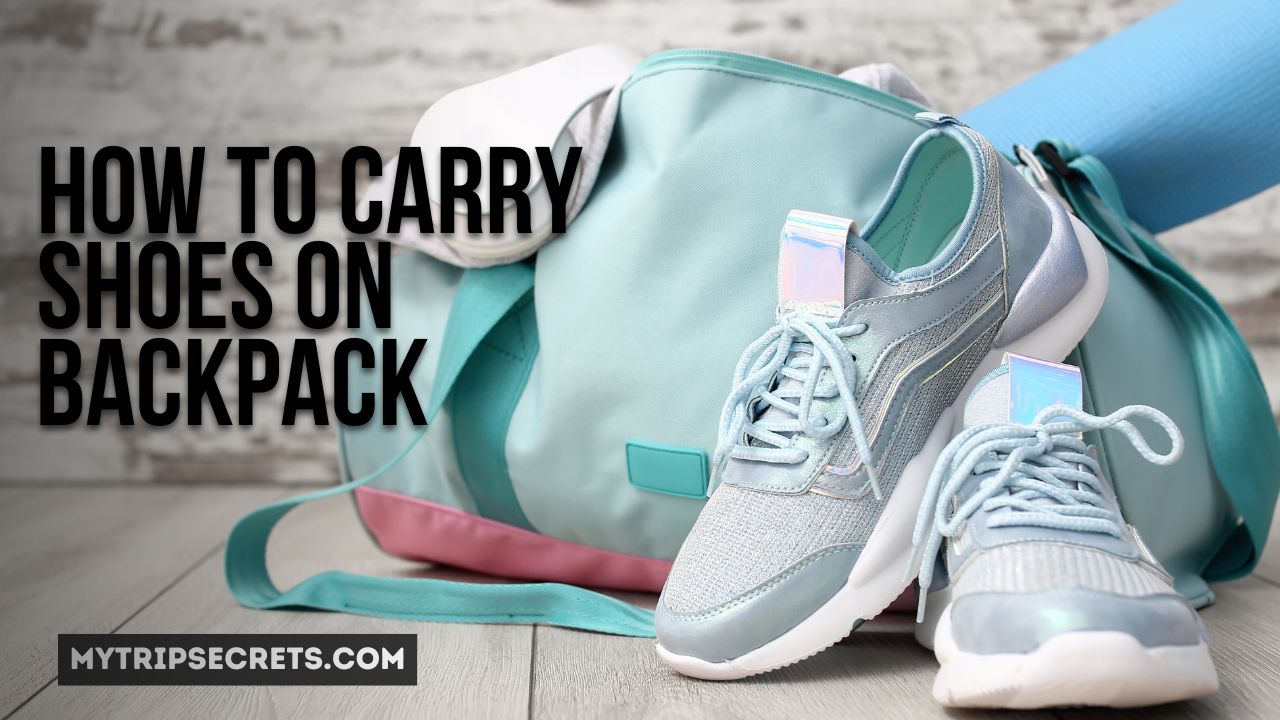Packing for a trip can be tricky, especially when you need to bring along footwear. While bulky sneakers and boots take up precious space in your backpack, going barefoot is not an option. Carrying shoes the wrong way can also damage them or cause back pain from an uneven load. This article will teach you the best practices for transporting shoes of all kinds using only a standard backpack.
Contents
- 1 The Ultimate Guide On How to Carry Shoes on Backpack
- 2 Packing Considerations for Different Shoe Types
- 3 5 Best Methods to Carry Your Shoes On Backpack
- 4 Special Tips for Air Travel
- 4.1 Frequently Asked Questions (FAQs)
- 4.2 Should shoes go in first before other items when packing backpack?
- 4.3 What are the best materials for backpack shoe storage?
- 4.4 How can I prevent shoe odor when packing them?
- 4.5 Any suggestions for keeping nice shoes damage-free?
- 4.6 What should I use to stuff shoes to hold their shape?
- 5 Key Takeaways
The Ultimate Guide On How to Carry Shoes on Backpack
Having the right footwear is essential when traveling. Whether you need sturdy hiking boots for the trails or dress shoes for a nice dinner, being able to store them properly in your bag makes a world of difference. Here are some key reasons to use backpack shoe-carrying methods:
- Saves room in your luggage: Shoes often take up a lot of suitcase space that could be used for clothing and other gear. Keeping them in your backpack frees up packing real estate.
- Avoids damage: Tossing footwear loosely into luggage can cause scuffs and warp the shape. Carrying them the right way keeps them looking pristine.
- Prevents back strain: Improperly packing shoes can throw off the weight distribution in your bag. This can leave your shoulders and back sore.
Packing Considerations for Different Shoe Types
Not all footwear should be carried the same way in your backpack. The best practices can vary quite a bit based on the size, shape, and delicacy of the materials. Here’s a breakdown of factors to consider for common shoe varieties travelers pack:
Sneakers
Having comfortable walking or running shoes is essential for activity-focused getaways involving lots of movement. Because of their chunky shape and durable fabrics, you can store standard sneakers directly in a backpack quite easily. Still, pay mind to the following:
- Ensure the shoes are dry first before packing – trapped moisture causes odor.
- Stuff socks or a shirt into the toes to help hold the shape if needed.
- If possible, keep them towards the outside of the bag to access frequently.
- Check periodically for compression damage during the trip.
Hiking Boots
For those embarking on serious backcountry treks, a sturdy pair of hiking boots can be essential. However, their rigid, heavy-duty construction makes them harder to pack neatly. Pay attention to these tips:
- Waterproof the shoes to save space – dry pair takes up less room.
- Stuff inside tightly with socks or other soft items to hold shape.
- Secure safely in a dedicated compartment or central pouch away from gear they could damage.
- Wrap laces neatly around rather than loose to reduce tangling.
Based on testing done by outdoor gear review site Switchback Travel, poorly packed hiking boots caused up to 35% more backpack disorganization. So stowing them correctly makes a big difference.
Dress Shoes
While casual sneakers or boots are fine shoved in a bag, dress or leather shoes require more care. On trips involving professional events or fancy outings, travelers must keep their footwear looking polished. Here are some key dress shoe packing pointers:
- Use shoe bags or wrap in tissue to prevent scuffing/moisture damage.
- Pad tightly with socks or cloth to hold structure – avoid compression damage.
- Place centrally near back/spine of pack for balance and security.
- Check periodically for wrinkles or object impressions.
In polls of frequent business travelers by The Points Guy, over 80% said they had ruined nice shoes by improperly packing them for trips. Use care when loading dress pairs into your backpack.
High Heels
While going super glam may not be every trip’s agenda, special events like weddings, cruises, or casinos may call for heels. Although tricky, with our tips you can pack heels without wrecking your feet – or your fabulous shoes:
- Select space-saving heels when possible – avoid thick platforms.
- Stuff the toes gently with cushioning and wrap in soft cloth.
- Use shoe bags, boxes, or wrap to prevent damage.
- Place centrally in pack near structural supports.
- Always hand-carry in garment bag for air travel outfits.
In an experiment by POPSUGAR UK, shoes packed improperly caused up to 6 times more luggage disarray. So handle those delicate heels with care.
Flip Flops/Sandals
Finally, sandals and flip flops are another popular footwear choice for tropical getaways in warm climates. As laid-back shoes, they can generally be crammed into packs without concern. Nonetheless, heed these suggestions:
- Let any damp sandals fully dry out before packing to avoid mildew smells.
- Stuff socks/paper into the straps or between soles to limit warping.
- Putting them loose into exterior mesh pockets lets them air out.
- Check buckles/clasps periodically for breakage or undoing.
While informal, flip flops still require care to avoid long-term distortion damage from cramming. Pack them per suggestions above.
5 Best Methods to Carry Your Shoes On Backpack

Okay, so now that you know how to assess packing needs based on different shoe types, what are the tried-and-true techniques for actually transporting them in backpacks? Here we review 5 top methods, with the pros and cons of each:
1. Pack Shoes at Bottom/Exterior
The most straightforward option is packing your shoes directly at the bottom of your backpack or on the outside. However, this does come with some notable drawbacks:
Pros
- Keeps shoes securely contained and compressed
- Leaves top space free for other gear
- Easy to access shoes quickly
Cons
- Can throw off weight distribution/balance
- Scuffs exterior material against ground
- Offers less organizational control
This method works fine for short trips where shoe access is needed regularly. But for extended excursions, an interior packing approach may work better.
2. Use Exterior Mesh Shoe Compartments
Some travel backpacks come equipped with specialized exterior mesh pouches designed specifically for shoes. These keep your footwear secure while still allowing airflow:
Pros
- Keeps shoes visible and accessible
- Allows ventilation/drying out
- Gets shoes off wearer’s back area
Cons
- Can overload a single area – causes imbalance
- Exposes shoes to weather elements
- Provides less padding/protection
Side mesh shoe areas give handy airflow and access but lack secure cradling. They are best used for casual sneakers only.
3. Use Specialty Shoe Bags/Cases
Investing in a quality dedicated shoe bag or case lets you stow footwear securely while protecting your backpack interior from dirt. However, this solution does have some limitations:
Pros
- Protects shoes and pack interior
- Keeps shoes contained together
- Some offer padding
Cons
- Can take up valuable room
- Adds cost if purchasing bags/cases
- Extra thing to keep track of
Purchasing packs with built-in shoe cases helps avoid downsides. Or invest in aftermarket cases to maximize space.
4. Stow Vertically in Interior Walls
If your backpack has vertical storage spaces along the main walls, securely stowing your wrapped shoes here positions them ergonomically along your spine for comfort:
Pros
- Keeps weight centered on back
- Supports shoulders better
- Uses empty interior space
Cons
- Can be difficult to access
- Offers less protection
- Shoes may compress over time
Stowing shoes flat against internal walls only works for backpacks with vertical storage design. But it provides superb weight distribution when structured properly.
5. Secure Centrally with Compression Straps
Finally, the optimal packing spot for larger hiking boots and dress shoes is often dead center. Securing bulky footwear here with compression straps keeps the load balanced and stable:
Pros
- Centralizes weight perfectly
- Keeps shoes immobile
- Allows easy access to both shoes
Cons
- Requires pack with straps
- Can squish shoes over time
- Makes other items harder to access
If your backpack boasts both central pouches and compression features, use them in tandem to optimally transport larger shoes.
Special Tips for Air Travel
If packing your shoes strategically for flights, keep these additional pointers in mind:
- Place soft shoes in personal underseat area to swap on long flights
- Harder shoes won’t fit under seat – store centrally and securely in main cabin
- Hand-carry dress shoes in garment bags if possible to prevent damage
- Consider airport bag check services for bulky hiking boots
Shoes that leak dirt or have thick soles may require TSA additional screening. So keep those hassles in mind when packing for flights.
Frequently Asked Questions (FAQs)
Here are answers to some frequently asked questions about transporting shoes in backpacks:
Should shoes go in first before other items when packing backpack?
It’s generally best to pack shoes first or strategically layer them between items. Placing them on the bottom or edges helps balance backpack loads. Just be sure less delicate items cushion them.
What are the best materials for backpack shoe storage?
Mesh, canvas, nylon, microfiber, and specialized shoe pouches make great breathable and protective materials for storing shoes internally. Hard-sided cases also work well but take up prime real estate.
How can I prevent shoe odor when packing them?
Letting shoes fully air out beforehand is crucial, especially if damp, muddy, or sweaty. Baking soda and dryer sheets also absorb odors. Teabags and charcoal inserts fight smells too.
Any suggestions for keeping nice shoes damage-free?
Use shoe bags, wrap them in soft items like socks and t-shirts, and place centrally near structural back padding. Compression straps also immobilize nice shoes so they don’t slide and scuff. Hand-carrying further protects them.
What should I use to stuff shoes to hold their shape?
Socks, t-shirts, paper, dry grocery bags, bubble wrap, packing cubes, and shoe trees all make excellent internal shoe fillers to maintain form. Just avoid overstuffing – slight compression keeps shoes contained.
Key Takeaways
I hope these tips give you newfound confidence for safely packing shoes for future trips using just your trusty backpack! Here are the key lessons to remember:
- Assess your shoe types and materials first when deciding on packing methods
- Use specialty gear like shoe cases, compression straps, and filler items to transport shoes cleanly and securely
- Place shoes strategically near structural supports in the bag interior to distribute weight
- Give delicate dress shoes, heels, sandals extra protection by wrapping and hand-carrying when possible
- Check periodically throughout travels for damage or shifting
Knowing these solid approaches makes carrying shoes of nearly any variety a painless process! Just be sure to implement the practices best suited for your specific pair’s needs. Most importantly, walk comfortably while preventing harm to your footwear. Your feet and pack will thank you!

